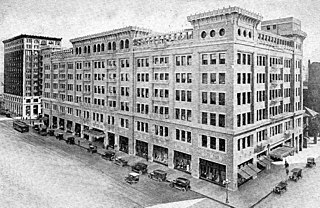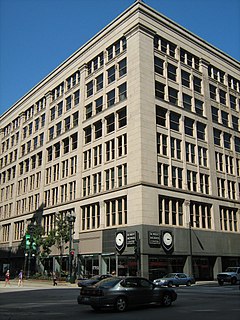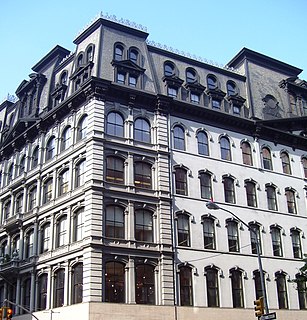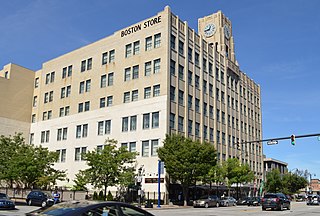
Stern's was a regional department store chain serving the U.S. states of New York, New Jersey, and Pennsylvania. The chain was in business for more than 130 years.
Jordan Marsh was an American department store chain that was headquartered in Boston, Massachusetts, and operated throughout New England. It was founded by Eben Dyer Jordan and Benjamin L. Marsh in 1841. The ownership of Jordan Marsh was transferred between several holding companies during its operation, including Hahn Department Stores in 1928, Allied Stores in 1935, and Federated Department Stores in 1988. The brand was retired and most stores were converted into the New York City-based Macy's in 1996.

Meier & Frank was a prominent chain of department stores founded in Portland, Oregon, and later bought by The May Department Stores Company. Meier & Frank operated in the Pacific Northwest from 1857 to 2006.

Broadway, until 1890 Fort Street, is a thoroughfare in Los Angeles County, California, USA. The portion of Broadway from 3rd to 9th streets in the Historic Core of Downtown Los Angeles, was the city's main commercial street from the 1910s until World War II, and is the location of the Broadway Theater and Commercial District, the first and largest historic theater district listed on the National Register of Historic Places (NRHP). With twelve movie palaces located along a six-block stretch of Broadway, it is the only large concentration of movie palaces left in the United States.

J. W. Robinson Co., Robinson's, was a chain of department stores operating in the Southern California and Arizona area, previously with headquarters in Los Angeles, California.

The South Omaha Main Street Historic District is located along South 24th Street between M and O Streets in South Omaha, Nebraska. It was added to the National Register of Historic Places in 1989. Home to dozens of historically important buildings, including the Packer's National Bank Building, the historic district includes 129 acres (0.52 km2) and more than 32 buildings.

Macy's Herald Square is the flagship of Macy's department store, as well as the Macy's, Inc. corporate headquarters, on Herald Square in Manhattan, New York City. The building's 2.5 million square feet (230,000 m2), which includes 1.25 million square feet (116,000 m2) of retail space, makes it the largest department store in the United States and among the largest in the world.

The Goldthwaite Block is a historic commercial building on 99-103 Main Street in Brockton, Massachusetts. Built in 1892, it forms part of one of the city's best-preserved assemblages of 19th-century commercial architecture, alongside the Lyman Block and Howard Block. The building was listed on the National Register of Historic Places in 1982.

The Lower Woodward Avenue Historic District, also known as Merchant's Row, is a mixed-use retail, commercial, and residential district in downtown Detroit, Michigan, located between Campus Martius Park and Grand Circus Park Historic District at 1201 through 1449 Woodward Avenue and 1400 through 1456 Woodward Avenue. The district was listed on the National Register of Historic Places in 1999.

The Main Street Historic District in Lake Geneva, Wisconsin is a 2.5-acre (1.0 ha) historic district that was listed on the National Register of Historic Places on January 11, 2002. The listing was amended in some way in a revised listing on March 5, 2002. In 2002, there were 20 buildings in the district that were deemed to contribute to its historic character.

The Siegel-Cooper Company was a department store that opened in Chicago in 1887 and expanded into New York City in 1896. At the time of its opening, the New York store was the largest in the world.

Arnold Constable & Company was a department store chain in the New York City metropolitan area. At one point it was the oldest department store in America, operating for over 150 years from its founding in 1825 to its closing in 1975. At the company's peak, its flagship "Palace of Trade" in Manhattan – located at 881-887 Broadway at East 19th Street, through to 115 Fifth Avenue – was acknowledged to be the store which took the largest portion of the "carriage trade", in New York, serving the rich and elite of the city, such as the wives of Grover Cleveland, Andrew Carnegie, Thomas Edison, J.P. Morgan, John D. Rockefeller and Cornelius Vanderbilt.

The Frances Building and Echo Theater in southeast Portland in the U.S. state of Oregon is a property listed on the National Register of Historic Places. Built in 1911, it was added to the register in 1994. The Frances Building is a two-story structure that faces Southeast Hawthorne Boulevard, while the Echo Theatre is a one-story structure facing Southeast 37th Avenue. The adjoining buildings, constructed as parts of a single project, are separated by a party wall.

The Newman Brothers Building is a former commercial building in Joplin, Missouri. The building was the home of Newman's Department Store from 1910 to 1972. In 1990, the building was entered into the National Register of Historic Places. After going through several owners, the building is now occupied by Joplin city offices. It is located in the Joplin Downtown Historic District.

The Boston Store is a former department store located on State Street in downtown Erie in the U.S. state of Pennsylvania. The store itself was founded in 1885, with the building being constructed in 1929. At its peak, two other Boston Stores were opened, in addition to the downtown store. The Boston Store was closed in 1979. The building remained abandoned until 1988, when it was renovated into a combination apartment and commercial building, and was renamed Boston Store Place. The Boston Store was listed on the National Register of Historic Places in 1996.

The Goodyear Block, also known as the Arbeiter Block is a commercial building located at 138 E. Main Street in Manchester, Michigan. It was listed on the National Register of Historic Places in 1993.

The Iron Mountain Central Historic District is a historic district, broadly located between Fleshiem and C Streets and between Iron Mountain and Stockbridge Avenues in Iron Mountain, Michigan. The district covers the city's central business district and adjacent areas. It is primarily commercial, but also contains the historic county courthouse complex, and school, library, and church buildings. It was listed on the National Register of Historic Places in 2013.

The Braastad–Gossard Building, also known as the Gossard Building or Pioneer Square, is a commercial building located at 308 Cleveland Avenue in Ishpeming, Michigan. It was listed on the National Register of Historic Places in 2015.

Marston's was a department store based in San Diego, California, and founded by city leader George Marston. It had a downtown main store on Sixth Street and opened two suburban branches before being sold to The Broadway in 1961.

7th Street is a street in Los Angeles, California running from S. Norton Ave in Mid-Wilshire through Downtown Los Angeles. It goes all the way to the eastern city limits at Indiana Ave., and the border between Boyle Heights, Los Angeles and East Los Angeles.

























